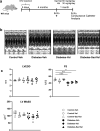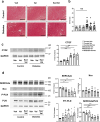Sacubitril/valsartan improves diastolic left ventricular stiffness with increased titin phosphorylation via cGMP-PKG activation in diabetic mice
- PMID: 39443532
- PMCID: PMC11499646
- DOI: 10.1038/s41598-024-75757-8
Sacubitril/valsartan improves diastolic left ventricular stiffness with increased titin phosphorylation via cGMP-PKG activation in diabetic mice
Abstract
Titin, a giant sarcomeric protein, regulates diastolic left ventricular (LV) passive stiffness as a molecular spring and could be a therapeutic target for diastolic dysfunction. Sacubitril/valsartan (Sac/Val), an angiotensin receptor neprilysin inhibitor, has been shown to benefit patients with heart failure with preserved ejection fraction. The effect of Sac/Val is thought to be due to the enhancement of the cGMP/PKG pathway via natriuretic peptide. In this study, the effects of Sac/Val on LV diastolic dysfunction are demonstrated in a mouse diabetic cardiomyopathy model focusing on titin phosphorylation. Sac/Val-treated diabetic mice showed a greater increase in myocardial levels of cGMP-PKG than Val-treated and control mice. Conductance catheter analysis showed a significant reduction in LV stiffness in diabetic mice, but not in non-diabetic mice. Notably, diastolic LV stiffness was significantly reduced in Sac/Val-treated diabetic hearts compared with Val-treated or vehicle-treated diabetic mice. The phosphorylation level of titin (N2B), which determines passive stiffness and modulates active contraction, was higher in Sac/Val-treated hearts compared with Val-treated hearts in diabetic mice. Given that alteration of titin phosphorylation through PKG contributes to myocardial stiffness, the beneficial effects of Sac/Val in heart failure might be partly attributed to the induction of titin phosphorylation.
Keywords: Cardiomyopathy; Diabetes; Diastolic dysfunction; HFpEF; Myocardial stiffness; Titin.
© 2024. The Author(s).
Conflict of interest statement
N.K. was supported by a joint research fund from Novartis Pharma, which provided the sacubitril/valsartan and valsartan used in the present study.
Figures




Similar articles
-
Sacubitril/valsartan inhibits obesity-associated diastolic dysfunction through suppression of ventricular-vascular stiffness.Cardiovasc Diabetol. 2021 Apr 21;20(1):80. doi: 10.1186/s12933-021-01270-1. Cardiovasc Diabetol. 2021. PMID: 33882908 Free PMC article.
-
Sacubitril/Valsartan Improves Diastolic Function But Not Skeletal Muscle Function in a Rat Model of HFpEF.Int J Mol Sci. 2021 Mar 30;22(7):3570. doi: 10.3390/ijms22073570. Int J Mol Sci. 2021. PMID: 33808232 Free PMC article.
-
Sacubitril/Valsartan attenuates progression of diabetic cardiomyopathy through immunomodulation properties: an opportunity to prevent progressive disease.Cardiovasc Diabetol. 2025 May 14;24(1):206. doi: 10.1186/s12933-025-02741-5. Cardiovasc Diabetol. 2025. PMID: 40369551 Free PMC article.
-
The Efficacy and Safety of Sacubitril/Valsartan in Heart Failure Patients: A Review.J Cardiovasc Pharmacol Ther. 2022 Jan-Dec;27:10742484211058681. doi: 10.1177/10742484211058681. J Cardiovasc Pharmacol Ther. 2022. PMID: 34994233 Review.
-
Beneficial and harmful effects of sacubitril/valsartan in patients with heart failure: a systematic review of randomised clinical trials with meta-analysis and trial sequential analysis.Open Heart. 2020 Nov;7(2):e001294. doi: 10.1136/openhrt-2020-001294. Open Heart. 2020. PMID: 33257469 Free PMC article.
Cited by
-
Roles of Autophagy, Mitophagy, and Mitochondria in Left Ventricular Remodeling after Myocardial Infarction.Rev Cardiovasc Med. 2025 Mar 24;26(3):28195. doi: 10.31083/RCM28195. eCollection 2025 Mar. Rev Cardiovasc Med. 2025. PMID: 40160572 Free PMC article. Review.
-
The association of life's essential 8 with prevalence of chronic respiratory diseases in adults: insights from NHANES 2007-2018.BMC Pulm Med. 2025 Jul 9;25(1):331. doi: 10.1186/s12890-025-03775-x. BMC Pulm Med. 2025. PMID: 40634937 Free PMC article.
References
-
- Dunlay, S. M., Roger, V. L. & Redfield, M. M. Epidemiology of heart failure with preserved ejection fraction. Nat. Rev. Cardiol. 14, 591–602. 10.1038/nrcardio.2017.65nrcardio.2017.65[pii] (2017). - PubMed
-
- Kawaguchi, M., Hay, I., Fetics, B. & Kass, D. A. Combined ventricular systolic and arterial stiffening in patients with heart failure and preserved ejection fraction: implications for systolic and diastolic reserve limitations. Circulation 107, 714–720. 10.1161/01.cir.0000048123.22359.a0 (2003). - PubMed
-
- Zile, M. R., Baicu, C. F. & Gaasch, W. H. Diastolic heart failure–abnormalities in active relaxation and passive stiffness of the left ventricle. N. Engl. J. Med. 350, 1953–1959. 10.1056/NEJMoa032566 (2004). - PubMed
-
- Burkhoff, D., Mirsky, I. & Suga, H. Assessment of systolic and diastolic ventricular properties via pressure-volume analysis: a guide for clinical, translational, and basic researchers. Am. J. Physiol. Heart Circ. Physiol. 289, H501-512. 10.1152/ajpheart.00138.2005 (2005). - PubMed
MeSH terms
Substances
LinkOut - more resources
Full Text Sources

